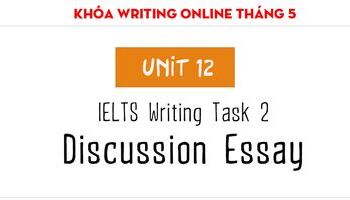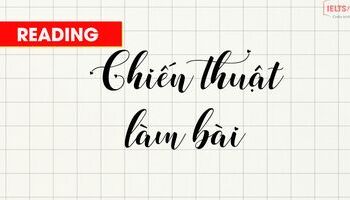Tiếp tục chuỗi bài học về IELTS Writing Task 2, hôm nay, các bạn cùng tìm hiểu về dạng bài DISCUSSION ESSAY.
Đây là một dạng bài thường xuất hiện trong bài thi và đòi hỏi phải biết phân tích, làm rõ các luận điểm, nêu quan điểm chi tiết do đó cần chú ý thật kỹ. Khi theo dõi bài học, các bạn hãy xem hết video và có gì thắc mắc, có thể comment ngay để được giải đáp nhé.
Video Discussion Essay
Cách viết bài Discussion Essay
1. Tìm hiểu rõ dạng bài
Cô sẽ lấy ba ví dụ như sau để các bạn dễ hiểu hơn:
Example 1: Computers are being used more and more in education and so there will soon be no role for the teacher in education. To what extent do you agree or disagree?
-> Đây là đề bài thuộc dạng opinion essay, bởi ta có thể thấy ngay instruction word của đề bài là “agree or
disagree”.
Example 2: Computers are being used more and more in education. Discuss the advantages and disadvantages and give your own opinion.
-> Hiển nhiên khi nhìn vào đề thì ta biết đây là đề bài thuộc dạng advantage – disadvantage essay
Example 3: Computers are being used more and more in education. Some people say that this is a positive trend, while others argue that it is leading to negative consequences. Discuss both sides of this argument and then give your own opinion.
-> Đây là đề bài thuộc dạng bài discussion essay bởi trong câu hỏi ta bắt gặp instruction word quen thuộc “Discuss both sides of this argument and then give your own opinion”.
Như chúng ta có thể thấy, đề bài sẽ đưa ra hai ý kiến trái chiều nhau và yêu cầu chúng ta phải thảo luận về cả hai ý kiến đó và đưa ra quan điểm cá nhân của mình. Hãy chắc chắn rằng trong bài viết của mình đều phải có những yêu cầu này nhé không thì chúng ta có thể sẽ bị trừ điểm nha.
2. Cấu trúc làm bài chung
Đối với dạng bài IELTS Writing này thì các bạn nên đi theo cấu trúc làm bài như sau:
Introduction – Giới thiệu
Sentence 1- Paraphrase Question – Viết lại câu hỏi
Sentence 2- State Both Points of View – Đưa ra 2 ý kiến trong đề
Sentence 2- Thesis Statement – Nêu quan điểm cá nhân
Sentence 3- Outline Sentence – Câu dàn ý
Main Body Paragraph 1 – Đoạn thân bài thứ 1
Sentence 1- State first viewpoint – Đưa ra ý kiến 1
Sentence 2- Discuss first viewpoint – Thảo luận về ý kiến 1
Sentence 3- Reason why you agree or disagree with viewpoint – Đưa ra lý do đồng ý hoặc không đồng ý với ý kiến đó.
Sentence 4- Example to support your view – Lấy ví dụ chứng minh luận điểm của bạn.
Main Body Paragraph 2 – Đoạn thân bài thứ 2
Sentence 1- State second viewpoint - Đưa ra ý kiến 2
Sentence 2- Discuss second viewpoint - Thảo luận về ý kiến 2
Sentence 3- Reason why you agree or disagree with viewpoint - Đưa ra lý do đồng ý hoặc không đồng ý với ý kiến đó.
Sentence 4- Example to support your view - Lấy ví dụ chứng minh luận điểm của bạn.
Conclusion – Phần Kết
Sentence 1 - Summary – Tóm tắt lại
Sentence 2 - State which one is better or more important - Chọn ý kiến nào quan trọng hơn.
3. Phân tích các bước làm bài
Bước 1: UNDERSTANDING THE TASK
Some cities create housing for growing populations by building taller buildings while other cities have opted to build on wider areas of land.
Discuss both views and give your own opinion?
Cấu trúc chung:
Introduction:
- Paraphrase the 2 provided opinions
- Thesis statement: clearly state the writer’s viewpoint (agree with one or disagree with both)
- Each body paragraph explains one opinion
- Reasons and examples
- Conclusion: Writer’s opinion (agree with one or disagree with both)
Common strategy:
Body paragraph 1: discuss opinion 1
Body paragraph 2: discuss opinion 2
Conclusion: agree with one of them
A new strategy !
- Body paragraph 1: discuss 2 opinions
- Body paragraph 2: Writer’s opinion (Disagree with both)
- Conclusion: summarise
Bước 2: Brainstorming
Taller buildings:
- Pro: Accommodation and life amenities for more population with limited areas of land.
- Con: high population density => traffic jam and pollution.
Wider areas:
- Pro: low population density => less traffic jam, less pollution
- Con: virtually impossible with currently limited land resources in metropolises
Writer’s opinion:
- Rural development => prevent the influx of migrants from the very start.
Bước 3: Viết bài - Sample Answer
In order to address the prevalent problem of overpopulation, some cities construct higher apartment blocks while others create larger residential areas. From a personal viewpoint, since both these solutions have their own benefits and drawbacks, a third one which is rural development hereby will be presented.
For once, towering multifunctional apartment complexes can provide urban citizens with offices, accommodation, life amenities, and venues for recreation or entertainment within limited areas of land in the downtowns. However, they create a high level of population density with inevitable consequences including traffic congestion and pollution. More spacious residential areas, on the other hand, reduce population density so that residents will have more green space and fresh air. Nonetheless, given the currently restricted land resources in many metropolises in Vietnam, such as Hanoi and Ho Chi Minh City, this solution is virtually impossible. After decades of developing without appropriate urban planning, these cities nearly depleted all their land resources.
With the aforementioned pros and cons of both the two provided options, developing rural areas can be a more fundamental solution. It is unquestionable that rural residents flock to cities in search of a better life. Therefore, bringing what they need closer to their hometown is the only way to reduce the influx of migrants into megacities from the very root of this issue. Vietnam’s National Target Program on New Rural Development can be an excellent example. With infrastructure development and improvements in education, healthcare, and the labour market, Vietnam’s countryside can ensure higher standards of living for inhabitants, which removes the need for migration.
In conclusion, although taller buildings and wider residential areas have their own benefits, they cannot resolve the core of overpopulation. Socioeconomic development in rural regions, on the other hand, is a more convincing solution.
(292 words, band 7.0)
Useful vocabulary
Luyện tập
Dưới đây chúng ta cùng Brainstorming với đề thi thật chủ đề Sports, bạn tiếp tục viết bài nhé.
Đề bài: Many people believe that success in sports depends on physical ability, while others think there are other important factors. Discuss both views in give your opinion.
Dec 2022 (computer-based)
Đây là một đề bài tưởng chừng như rất dễ về các main ideas, nhưng điểm khó của nó nằm ở cách giải thích vấn đề và các ví dụ.
Brainstorming
Idea 1: Physical ability
Reason: để trở thành các vđv hàng đầu trong hầu hết các môn thể thao đều đỏi hỏi sự vượt trội về thể chất như thể lực, tốc độ, sức bền, khả năng bứt tốc, sự dẻo dai. Một số môn còn có những đòi hỏi rất đặc trưng về thể chất của vđv (bóng rổ - chiều cao; bơi và võ thuật đối kháng – sải tay; vật và cử tạ - trọng lượng cơ thể)
Explain + Example: sự thành công của rất nhiều vđv với các chỉ số thể chất lý tưởng: Yao Ming, bóng rổ, cao 2.29 m – áp đảo các vđv chuyên nghiệp khác tại Giải bóng rổ nhà nghề Mỹ NBA; Michael Phelps, sải tay 2 m / chiều cao 1.93m, hơn hẳn người thường (sải tay = chiều cao cơ thể)
=> Thể chất đặc biệt = nền tảng cần thiết cho thể thao đỉnh cao
Idea 2: Other factors
Reason 1: Trong các môn thể thao đồng đội, chiến thuật của huấn luyện viên và sự phối hợp giữa các đồng đội tạo nên thành công.
Explain + Example: những HLV xuất sắc trong bóng đá: Ancelotti, Guardiola, Mourinho, Wenger, Klopp, Ferguson, etc đều có những phong cách của riêng mình để giúp đội bóng giành thắng lợi
Reason 2: tinh thần quyết tâm không bỏ cuộc để vượt qua những tình cảnh khó khăn
Explain + Example: Liverpool năm 2005, chung kết UEFA Champion League, thua 0-3 trong hiệp 1, gỡ hòa 3-3 trong hiệp 2, chiến thắng bằng penalty
Reason 3: khả năng bình tĩnh.
Explain + Example: lo lắng, căng thẳng, hay nóng nảy đều dẫn đến hậu quả xấu (chơi xấu => bị trọng tài phạt, xử thua; quá căng thẳng => sút trượt penalty)
=> Thành công đòi hỏi các yếu tố tinh thần và nỗ lực tập thể
Vocabulary
Idea 1:
- physical superiority [n]: sự vượt trội về thể chất (so với người khác hoặc so với mặt bằng chung)
- stamina [n]: thể lực
- speed hoặc pace [n]: tốc độ
- acceleration [n]: gia tốc, khả năng bứt tốc
- flexibility [n]: sự dẻo dai, linh hoạt
- height [n]: chiều cao
- body weight [n]: trọng lượng cơ thể
- arm span, arm reach, wingspan [n]: sải tay (tính từ đầu ngón tay khi 2 cánh tay duỗi thẳng sang 2 bên)
- ideal physical measurements [n]: các chỉ số thể chất lý tưởng
Idea 2:
- team sport [n]: môn thể thao đồng đội
- strategy [n]: chiến thuật
- resolve / determination / willpower[n]: ý chí quyết tâm
- dire situations [n]: những tình huống, hoàn cảnh cực kỳ khó khăn
- composure [n]: sự bình tĩnh, tự tin, và kiểm soát bản thân
Lời kết, trên thực tế, trong IELTS Writing task 2 không thiếu các đề bài hoàn toàn tập trung vào một lĩnh vực khoa học hoặc đời sống.
Đã từng có những đề bài hỏi rất sâu về các chủ đề khó như Lịch sử (history), Du hành vũ trụ (space travel), Tâm lý và giáo dục trẻ em (children psychology and education), etc và nếu chẳng may thí sinh không có đủ kiến thức và từ vựng về chủ đề đó thì xin chia buồn, bạn đã mất 5 triệu. Để tránh rơi vào trường hợp trên, hi vọng các bạn có thể liên tục tích lũy vốn hiểu biết về nhiều các chủ đề đa dạng để chuẩn bị cho bài thi.
Bây giờ thì bạn cùng viết bài nha!
Vậy là chúng ta đã tìm hiểu cơ bản về dạng bài Discussion Essay rồi, các bạn lưu ý học tập hiệu quả nhé!
Để hiểu hơn cách viết các dạng bài khác, các bạn tham khảo bài viết này nữa:
IELTS Writing Task 2 - Các dạng câu hỏi và cách viết bài chi tiết





